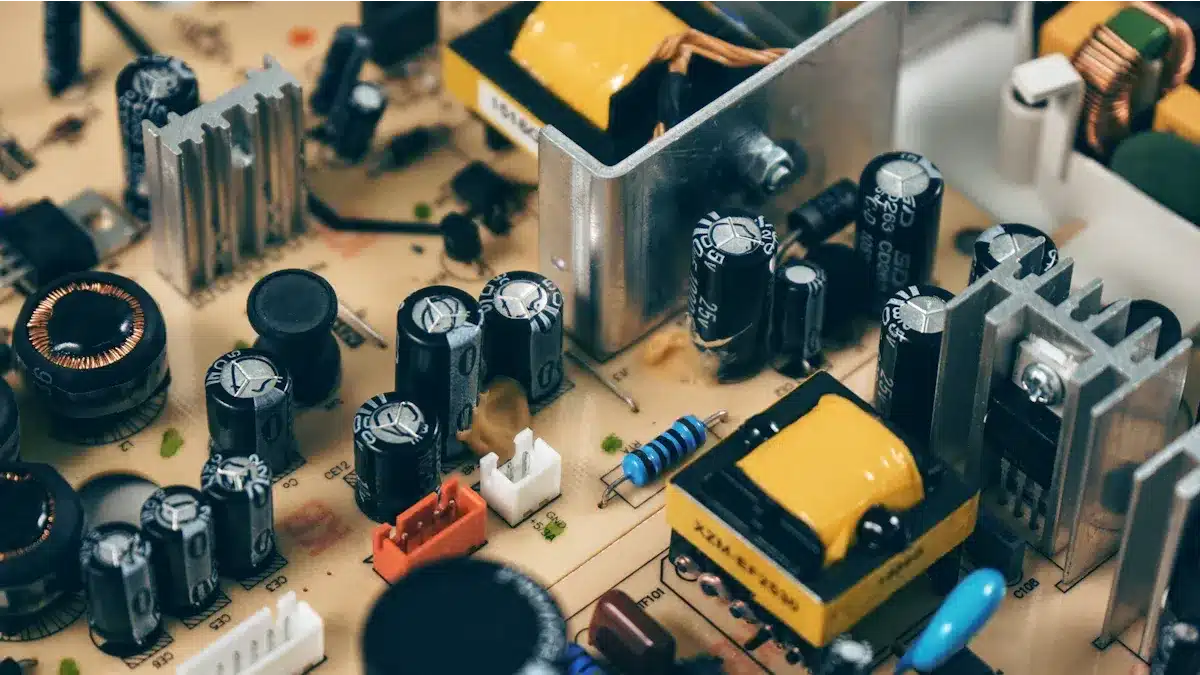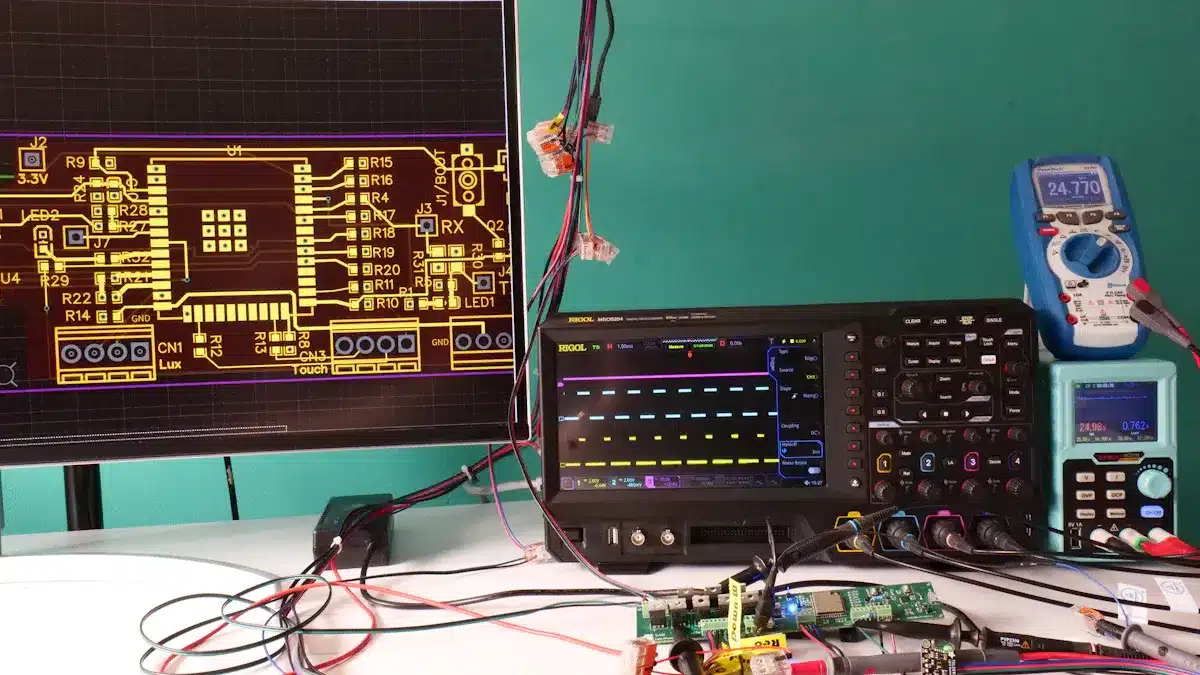
Choosing the right PCB design software is very important for your project. The features, ease of use, and price of the software can change how you design. For example, broken feedback can make projects cost more and take longer. A study showed that companies usually redo 2.8 boards for each project. Each redo costs about $46,000. So, you need to think about your needs and goals. This will help you avoid delays and extra costs in circuit board design.
Key Takeaways
Picking the right PCB design software can save time and money. Check your project needs to avoid expensive mistakes.
Find software with an easy-to-use interface. A simple design helps cut down errors and speeds up learning.
Simulation tools are important for testing designs before making them. They help find problems early, saving time and resources.
Teamwork features improve working together. Choose software that lets you edit in real-time and use cloud storage for better communication.
Think about the software cost carefully. Free tools might not have advanced features, so balance your budget with your project needs.
Key Features

When picking the right PCB design software, you need to think about some key features. These features can really affect how you design your circuit board. Here’s a list of important features to check for:
User Interface
A simple user interface is very important for good design. You want software that is easy to use and helps you find features without getting lost. Recent surveys show that people want these user interface features:
Feature | Description |
|---|---|
A large library with millions of components. | |
Simulation Tools | Tools for checking signal, power, and heat. |
Design Rule Checking | Checks to make sure designs can be made. |
3D Visualization | A 3D viewer to check where parts go. |
A clear user interface can lower mistakes and help you design better. For example, software with design rule checks (DRCs) helps you find problems early. This stops expensive errors. A simple interface also helps you learn faster, so you can start working quickly.
Design Capabilities
The design abilities of PCB software are very important, especially for multilayer boards. You should look for features that make designing easier, like:
Advanced routing tools for both manual and automatic routing.
A single design area that makes tasks easier.
Layer Stack Manager for multilayer PCB design.
Altium Designer is great for its advanced design features. It is one of the best PCB design software choices. It has strong tools that help with complex designs, so you can make high-quality layouts easily.
Simulation Tools
Simulation tools are very important for checking your designs before making real prototypes. They help you test how things work and find mistakes early. Here are some benefits of using simulation tools:
Benefit | Description |
|---|---|
Simulation checks if the idea will work before building hardware. | |
Testing Functionality | Tests if a circuit works well, making sure all parts fit together. |
Identifying Errors Early | Fixing problems during simulation is cheaper and faster than after making a prototype. |
Optimizing Designs | Engineers can improve designs for better performance without needing many physical prototypes. |
Using good simulation tools can really boost your chances of success with prototypes. They help you improve designs and make sure everything works right before starting production.
Collaboration Features
In today’s connected world, teamwork features are very important for engineering groups. Look for software that has:
Collaboration Feature | Description |
|---|---|
Lets teams save and access designs easily. | |
Cloud-based team collaboration | Helps teamwork from different places. |
Real-time collaboration via the cloud | Allows working on designs at the same time. |
Collaborative real-time editing for teams | Lets many users edit together. |
Browser-based design | No need to install, can be used anywhere. |
Real-time collaboration tools can speed up projects. They let many engineers work at once, improving communication and cutting down delays from misunderstandings.
Cost Options
Cost is always something to think about when choosing PCB design software. Here are some things to remember:
A yearly license for professional PCB design software can cost around $5,000 per seat.
Some options, like Mentor’s Powerlogic and Pads, were about $4,500 ten years ago.
Free and open-source PCB design tools often have fewer features than paid software.
While free tools might look good, they usually miss advanced features and support. Think about your budget and project needs carefully to find the best PCB design tools for you.
Best PCB Design Software

When you choose the best PCB design software, you have many options. Each software has its own features, strengths, and weaknesses. Let’s look at some of the top choices:
Altium Designer
Altium Designer is the top PCB design software in the industry. More than 100,000 engineers use it for complex projects. Here are its main pros and cons:
Advantage | Description |
|---|---|
Makes the design process easier, cutting down on manual work and mistakes. | |
Robust Architecture | Works well for large projects without slowing down. |
Advanced Constraint Management | Helps manage design rules and limits expertly. |
Real-time Adjustments | Lets you make changes right away, reducing costly fixes. |
Immediate Violation Alerts | Shows problems in real-time, lowering the chance of mistakes and rework. |
Powerful Analysis Tools | Gives quick feedback to spot design issues early. |
Handling Complex Designs | Great for managing multilayer designs, ensuring accuracy and reliability. |
But, Altium Designer has some downsides:
Steep Learning Curve: New users may find it hard to learn.
High Cost: It can be too expensive for hobbyists or small businesses.
High System Requirements: Needs strong hardware for the best performance.
Altium Designer costs about $325 each month or $3,850 each year, and a free trial is available.
KiCad
KiCad is a well-known open-source PCB design tool. It is completely free, making it great for students and hobbyists. Here are its pros and cons:
Strengths | Weaknesses |
|---|---|
Open-source with a supportive community | Not as integrated as other tools |
Works on different platforms | User experience can vary due to design differences |
KiCad’s open-source model encourages teamwork. Users can share resources and help improve it. This makes it a good choice for learning and hobby projects.
Eagle
Eagle, made by Autodesk, has a user-friendly interface and strong features. Here are some of its special features:
Feature | Description |
|---|---|
Schematic Capture and PCB Layout | Strong tools for making schematics and PCB layouts with easy switching. |
User-Friendly Interface | Simple and clean interface for both beginners and experienced users. |
Component Libraries | Large library of components with access to Autodesk library exchange. |
Auto-Routing | Saves time during the layout stage. |
Affordable | Cheaper than Altium, with free and paid options available. |
Community Support | Big community with lots of tutorials, forums, and resources. |
Integration with Autodesk Products | Works well with other Autodesk tools like Fusion 360. |
Eagle’s connection with Autodesk products allows for 3D modeling, syncing designs, and creating bills of materials (BoM). This greatly improves your design abilities.
CircuitMaker
CircuitMaker is a free PCB design tool for hobbyists and small startups. It supports teamwork and sharing, making it good for community projects. Here are its main uses:
Use Case Type | Description |
|---|---|
Hobbyists and Makers | Perfect for hobbyists because it is free and easy to use. |
Small Startups and Open Source Projects | Encourages teamwork and sharing, making it good for community projects. |
Educational Use | Helpful for teaching PCB design in schools at no cost. |
CircuitMaker’s cloud features allow real-time teamwork, improving the design process. This community focus helps users work together effectively.
ExpressPCB
ExpressPCB is made for beginners. Its simple interface focuses on basic features, making it less scary. Here are its downsides:
Limitation | Description |
|---|---|
Compatibility | Files do not work with standard PCB software, making it hard to switch. |
Functionality | The software is very basic, missing advanced features and error checking. |
Design Rule Checking | Very little design rule checking is available, which can cause mistakes in complex designs. |
Even with its downsides, ExpressPCB’s simplicity helps beginners. It combines schematic capture and PCB layout tools in one place, making the design process easier. This is great for quick prototypes and learning purposes.
User Reviews
Positive Experiences
Users often talk about good experiences with different PCB design tools. Here are some highlights:
Altium 365 makes project and library management easier for teams with complex designs.
The 3D visualization feature helps you see where components go, improving your design work.
Cloud-based teamwork features are great for real-time projects, especially for teams in different countries.
PADS Professional also manages complex PCB layouts well. It gives you precise control for detailed designs. Its connection with HyperLynx boosts your design skills with advanced analysis tools.
Autodesk EAGLE is known for its built-in user language programs (ULP). These programs automate boring tasks, saving you time. The autoroute function makes designing easier, which is important when time is tight in manufacturing.
Common Challenges
Even though many users like their PCB design software, they face some challenges. Here are some common problems:
Choosing the right components is important to avoid compatibility problems.
Understanding signal integrity and power integrity issues can be tough.
Users also find it hard to deal with size limits, mechanical integration, and heat issues. Power efficiency and electromagnetic compatibility (EMC) can also be tricky during design.
To get past these challenges, experienced users suggest hands-on training. This helps you learn quickly. Getting help from experienced users can really improve your understanding of the software. Using resources like training from Cadence can help fill knowledge gaps.
An expert can learn quickly in a few days with hands-on training.
Someone with over 15 years of experience can master the software in less than a month with regular use.
A complete beginner may take 3-6 months to get good without any prior knowledge.
Experienced designers stress the importance of having a good system of shortcuts. Having the same command functions across different design levels makes it easier to think. This helps you navigate the software better.
Choosing the right PCB design software is very important for your project. You need to think about your needs and goals before deciding. Here are some things to consider:
Following quality standards
Meeting deadlines on time
Clear pricing options
Good communication tools
Complete design improvement
A careful evaluation process can help you choose better. It makes things more efficient, increases accuracy, and saves money. Spend time looking at your choices and make a smart decision. This way, you will find the best PCB design software for your needs.
FAQ
What is PCB design software?
PCB design software helps you make layouts for circuit boards. It has tools for drawing schematics, designing PCB layouts, and simulating. You can use these tools to check if your designs work well before making them.
How do I choose the best PCB design software?
To pick the best PCB design software, think about your project needs. Look at things like how easy it is to use, design features, simulation tools, and price. Check how each software fits your specific needs for designing circuit boards.
Can I use free PCB design tools?
Yes, you can use free PCB design tools. But, they usually do not have advanced features like paid software. If you are new or working on simple projects, free tools can be a good place to start.
What are the key features of a PCB layout editor?
Key features of a PCB layout editor are an easy-to-use interface, design rule checking, simulation tools, and teamwork options. These features help you make accurate and effective circuit board designs.
How important are simulation tools in PCB design?
Simulation tools are very important in PCB design. They let you test your designs online, find mistakes early, and improve performance. Using simulation tools can save time and cut costs during the prototyping stage.
See Also
Essential Guidelines for Selecting Your Ideal Main PCBA
Key Considerations for Picking PCBA Inventory Management Software
Finding the Perfect PCBA Manufacturer for Your Business